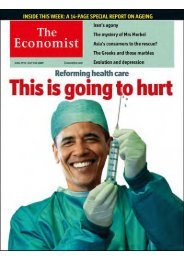Untitled - the ultimate blog
Untitled - the ultimate blog
Untitled - the ultimate blog
Create successful ePaper yourself
Turn your PDF publications into a flip-book with our unique Google optimized e-Paper software.
America loses its landlines<br />
Cutting <strong>the</strong> cord<br />
Aug 13th 2009 | SAN FRANCISCO<br />
From The Economist print edition<br />
Ever greater numbers of Americans are disconnecting <strong>the</strong>ir home telephones, with momentous<br />
consequences<br />
Alamy<br />
MUCH has been made of <strong>the</strong> precipitous decline of America’s newspapers. According to one much-cited<br />
calculation, <strong>the</strong> country’s last printed newspaper will land on a doorstep sometime in <strong>the</strong> first quarter of<br />
2043. That is a positively healthy outlook, however, compared with ano<strong>the</strong>r staple of American life: <strong>the</strong><br />
home telephone. Telecoms operators are seeing customers abandon landlines at a rate of 700,000 per<br />
month. Some analysts now estimate that 25% of households in America rely entirely on mobile phones (or<br />
cellphones, as Americans call <strong>the</strong>m)—a share that could double within <strong>the</strong> next three years. If <strong>the</strong> decline<br />
of <strong>the</strong> landline continues at its current rate, <strong>the</strong> last cord will be cut sometime in 2025.<br />
The impact of this trend will be greater than most people realise. It will make life increasingly difficult for<br />
telecoms firms, naturally. But it will also hurt all business that require landlines, as bills rise and business<br />
models are disrupted. No less seriously, <strong>the</strong> wi<strong>the</strong>ring fixed-line network threatens <strong>the</strong> work of <strong>the</strong><br />
emergency services, such as <strong>the</strong> police and fire brigade.<br />
The decline in landline use, which has been under way for several years, has picked up speed in recent<br />
months. In <strong>the</strong> first half of 2005 only 7.3% of households were mobile-only, according to America’s<br />
Centres for Disease Control and Prevention (CDC), which collects such data because it uses landlines for<br />
health surveys. By <strong>the</strong> end of last year <strong>the</strong> proportion had reached 20.2%—increasing by 2.7 percentage<br />
points in <strong>the</strong> second half of last year alone, <strong>the</strong> biggest-ever increase (see chart).<br />
The recession has accelerated cord-cutting, explains Stéphane<br />
Téral, an analyst at Infonetics Research, since people want to save<br />
money and are readier to sacrifice <strong>the</strong>ir landlines than <strong>the</strong>ir<br />
mobiles. But <strong>the</strong> problem is particularly acute in America because<br />
of <strong>the</strong> vastness of <strong>the</strong> country, which makes fixed-line networks<br />
expensive to run or improve. That, along with upheaval in <strong>the</strong><br />
telecoms industry in recent years, has made internet access over<br />
landlines in America annoyingly slow, even in <strong>the</strong> cities, leaving<br />
landlines much more dispensable than <strong>the</strong>y are in Europe.<br />
-88-








![[ccebbook.cn]The Economist August 1st 2009 - the ultimate blog](https://img.yumpu.com/28183607/1/190x252/ccebbookcnthe-economist-august-1st-2009-the-ultimate-blog.jpg?quality=85)



![[ccebook.cn]The World in 2010](https://img.yumpu.com/12057568/1/190x249/ccebookcnthe-world-in-2010.jpg?quality=85)
![[ccemagz.com]The Economist October 24th 2009 - the ultimate blog](https://img.yumpu.com/5191885/1/190x252/ccemagzcomthe-economist-october-24th-2009-the-ultimate-blog.jpg?quality=85)